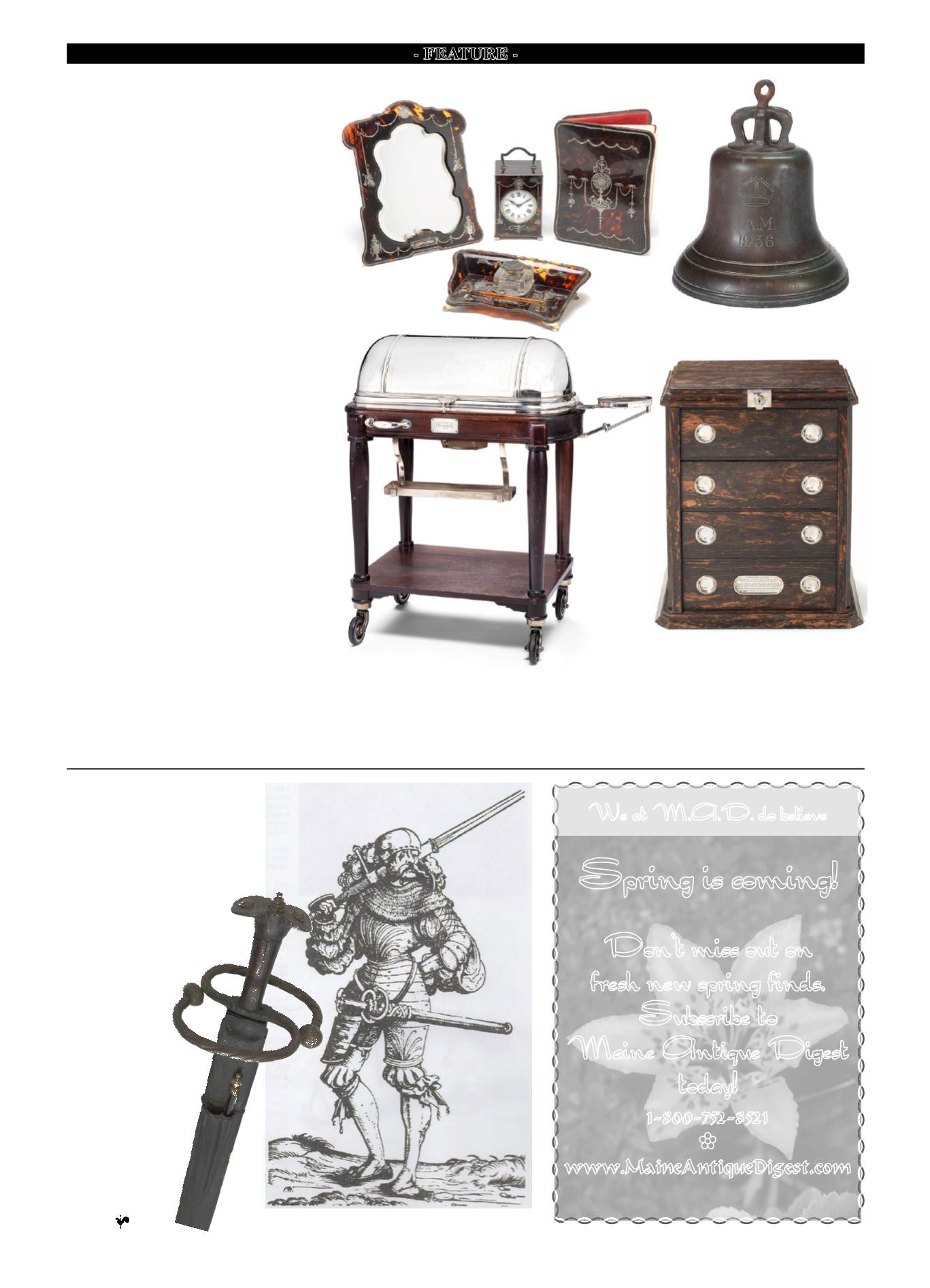

Maine Antique Digest, April 2015 9-D
- FEATURE -
“
Gentleman’s Library” sales held by Bonhams
rarely contain many books, but they do present an
eclectic mix of material that has, in part at least, male
slanted appeal, even if much of the material is not
quite the sort of thing one might expect to find in a
real gentleman’s library.
A silver-plated and stained wood beef warming/serv-
ing trolley, for example?
Bearing the name Christofle of Paris on two little
plaques, the trolley (seen below left
)
is of the type I
remember seeing for the first time as a young man when
taken out to lunch in a well known but even then rather
old-fashioned London restaurant—though at the time I
was rather overawed by the whole event and assumed
that in such elevated dining circles this was how “Roast
Beef, Yorkshire Pud, and Two Veg” was always served.
The domed roll-back cover opens to reveal a movable,
shaped-rectangular warming plate with two recessed
receivers. A fold-out plate-arm can be seen and slung
underneath is a tray for the carving utensils. In the latest
of these catch-all Knightsbridge sales, held January 27
and 28, it sold for a double estimate $22,684.
The fire bell seen far right bears the crowned cypher
of King George V and the legend “A.M. / 1936,” for Air
Ministry—but it is where this fire bell was used in 1940
that gives it its special appeal. It hung in the fire station
at RAF Biggin Hill and was probably in almost daily
use during the Battle of Britain, either to warn of enemy
attacks on England’s most celebrated airfield at the
time or to herald the return of the battered and damaged
Hurricanes and Spitfires of “The Few,” those brave
young men whose gallant efforts in seeing off the Luft-
waffe were so critical to Britain’s survival in the early
stages of World War II.
The bell was actually sold in an earlier “Gentle-
man’s Library” sale, in 2007, when (with dollar/sterling
exchange rates very different) it reached $11,280. This
time, the price was $7185, but the bell was being sold
to benefit the Spitfire Flight Scholarship for wounded
ex-servicemen.
Sold for $12,290 in the 964-lot Knightsbridge sale
was the Edwardian tortoiseshell and silver piqué five-
piece desk set illustrated above left
.
Bearing the 1904-
05 marks of William Comyns of London, its component
parts are a table mirror, in which a gentleman could I
suppose cast an admiring eye over his carefully waxed
moustache; a carriage clock; a waisted blotter; and a
desk stand fitted with cut-glass inkwell, quill pen, and
paper knife. A matching needle box is also part of the
ensemble but does not appear in the illustration. The
silver piqué work includes floral medallions, ribbons,
urns and musical trophies.
On second thought, perhaps this was something
intended for a lady’s desk, but the 21¼" high humidor
seen far right was almost certainly something for the
gentleman and sold for $18,905. Made of coromandel
wood and with silver mounts and handles by George
Betjemann & Sons of London, it also bears a plaque
Beef Will Be Served in the Gentlemen’s Library
The Christofle
beef warming and
carving trolley that
somehow found a
place in a “Gen-
tleman’s Library”
auction and sold
for $22,684 at
Bonhams.
An Edwardian tor-
toiseshell and silver
piqué-work desk set,
sold for $12,290 at
Bonhams.
The Biggin Hill bell, sold for
$7185 in Knightsbridge.
The Edwardian coromandel humidor,
sold for $18,905 in Knightsbridge.
explaining that is was presented
to John Pound on his election in
1904-05 to the post of Lord Mayor
of London, “…as a token of the
respect and high esteem in which he
is held by the whole of the employ-
ees of the firm John Pound & Co.”
Pound, I discover, was a lug-
gage manufacturer and retailer,
but though there is no sensible
reason why it should have been
so, something else not remarked
in the catalogue is the fact that
the maker was one of a family of
specialists in ornamental boxes
and the like whose most famous
member was someone who took no
interest in his family’s business—
the poet, writer, broadcaster, and
irrepressible Englishman Sir John
Betjeman.
The
Katzbalger
Kid
T
he 1530 woodcut by David de Necker
seen at right shows a German Lands-
knecht captain wearing half-armour who,
as well as the huge sword he rests against
his shoulders, has slung from his waist,
almost like a gun belt, a
katzbalger
or
broadsword of the type seen in the
other illustration beside it.
Dating from the first half of
the 16th century, this is a rare
survivor of a characteristic type
of Landsknecht broadsword. The
best known example is one
which can be seen in the
K u n s t h i s t o r i s c h e s
Museum in Vienna, but
in Europe there are
others in museums in
Dresden and Zurich
and, in England, in
the Royal Armouries
in Leeds. InAmerica, an
example may be seen in the
Kretzschmar von Kienbusch
collection at the Philadel-
phia Museum of Art.
The example offered by
Bonhams last year as part
of an arms and armour
sale of November 26
was sold at $33,445.
We atM.A.D. do believe
Spring is coming!
Don’t miss out on
fresh new spring finds.
Subscribe to
Maine Antique Digest
today!
1-800-752-8521
✿
www.MaineAntiqueDigest.com









